
We decided to visit Eden Garden which is a garden on Mount Eden in Auckland, set in 2 hectares (5 acres) of former quarry land, sort of like the Butchart Gardens in Victoria but on a smaller scale. It was established in 1964 and is open to the public for an admission fee. Eden Garden was donated to the people of New Zealand in 1965 and is managed by The Eden Garden Society. The garden’s many collections of plants include what is reputed to be the largest collection of camellias in New Zealand, vireyas (tropical rhododendrons) some of which are always in bloom, Japanese maples, magnolias, hibiscus, bromeliads, native trees, interesting rock formations, waterfalls, and a spectacular perennial garden. At the entrance they had the spectacular red Bougainvillea pictured above.

Bougainvillea is a genus of thorny ornamental vines, bushes, and trees with flower-like spring leaves near its flowers. Different authors accept between four and 18 species in the genus. They are native plants of South America from Brazil west to Perú and south to southern Argentina (Chubut Province). I love Bougainvillea but in Las Vegas we have just enough cold for a few days each winter to kill them. Bougainvillea was named after the French explorer, soldier and friend of Napoleon, Admiral Louis-Antoine de Bougainville who was the first French sea captain to cross the Pacific Ocean in about 1768, the same Capitaine Bougainville whose name is part of Auckland’s theatre complex. He brought the first Bougainvillea plants from Brazil to Europe where they created a sensation in the conservatories of the aristocracy. Bougainvillea is popular in warm climates including Australia, New Zealand and Hawai’i.
Odontonema strictum

Odontonema strictum is a species of plant in the family Acanthaceae. It is endemic to South America and grows to a height of two meters. It is suitable for container growing, but will only reach about 1 meter in a container. The waxy flowers grow in twelve inch red spikes, and in their native country they attract hummingbirds and butterflies when they bloom in the autumn.
Bee Balm

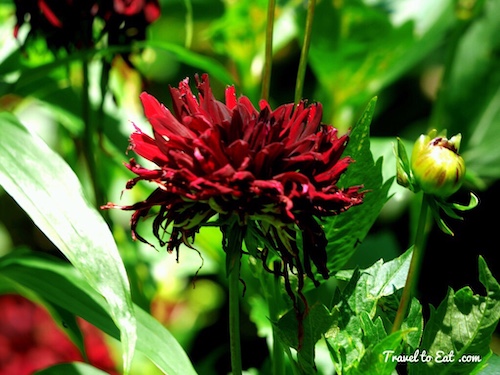
Monarda is a genus of flowering plants in the mint family, Lamiaceae. The genus is endemic to North America. Common names include bee balm, horsemint, oswego tea, and bergamot, the latter inspired by the fragrance of the leaves, which is reminiscent of bergamot orange (Citrus bergamia). The genus was named for the Spanish botanist Nicolás Monardes, who wrote a book in 1574 describing plants of the New World.
Dahlia

Dahlias are native to the high plains of Mexico and other parts of Central America. They were cultivated by the Aztecs in pre-Cortez times. They were introduced to Europe by the Spanish in 1784. They were first first grown in the Botanical Gardens in Madrid. Abbe Cavanille named the new plants Dahlias in honour of Andreas Dahl a Swedish naturalist and student of Carl Linnaeus. Dahlia Bishop of Auckland is richly crimson colored with a golden centre, dramatic against the dark foliage typical of the Bishop series. In the single dahlia stamens with their yellow pollen which is available for honeybees to collect, can be seen clearly . Pollen provides most of the protein in a bee’s diet.
Lilies

Lilium (members of which are true lilies) is a genus of herbaceous flowering plants growing from bulbs, all with large prominent flowers. Lilies are a group of flowering plants which are important in culture and literature in much of the world. Most species are native to the temperate northern hemisphere, though their range extends into the northern subtropics. Usually, orange is a color associated with Tiger Lilies, which usually have spots and/or stripes.
Daylily

A daylily is a flowering plant in the genus Hemerocallis. Thousands of cultivars have been registered by local and international Hemerocallis societies. Hemerocallis is now placed in family Xanthorrhoeaceae, subfamily Hemerocallidoideae, but formerly was part of Liliaceae (which includes true lilies). Hemerocallis is native to Eurasia, including China, Korea, and Japan, and this genus is popular worldwide because of the showy flowers and hardiness of many kinds. Daylilies are perennial plants, whose name alludes to the flowers which typically last no more than 24 hours. The flowers of most species open in early morning and wither during the following night, possibly replaced by another one on the same scape (flower stalk) the next day.
Vireya Rhododendrons

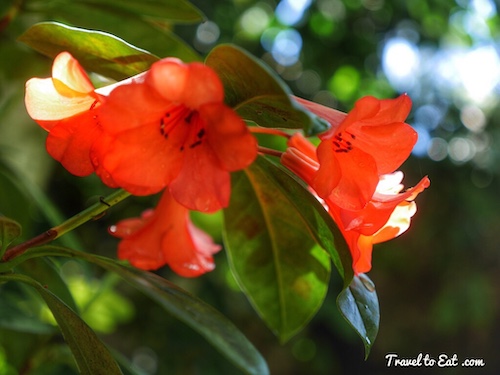




Vireyas are mostly evergreen shrubs growing to as high as 2 meters. They have tough dark green foliage, but are frost tender, coming from tropical regions. Vireya Rhododendrons have been grown for over a hundred years, yet it is only recently that these plants have been accepted by the gardening community for their ease of growing as a garden, bush-house or patio plant or even hanging baskets. size and shape of plant, leaf and flowers. Flower size and shape of plant, leaf and flowers vary widely, and many are beautifully perfumed. Most Vireyas are spectacularly different from the Rhododendron commonly grown in cooler climates, in fact they resemble Azaleas more than Rhododendtons. Although Vireyas originate in tropical regions, such as New Guinea, Indonesia and Malaysia, these plants have been grown successfully in parts of Australasia, in fact there is a major Vireya Nursery in Kerikeri in Northland New Zealand.
Abutilon


Abutilon is a large genus of flowering plants in the mallow family, Malvaceae. It is distributed throughout the tropics and subtropics of the Americas, Africa, Asia, and Australia. General common names include Indian mallow and velvetleaf. Abutilon × hybridum is a species name used for a wide variety of different types flowering plants of uncertain origin in the genus Abutilon. Because of the uncertainty surrounding the name, they are often considered a cultivar group: Abutilon x Hybridum Group or Abutilon Hybridum Group. They are cultigens, not occurring in the wild.
Angel Trumpet

Brugmansia is a genus of seven species of flowering plants in the family Solanaceae. Their large, fragrant flowers give them their common name of Angel Trumpets, a name sometimes used for the closely related genus Datura.
Fuchsia


The majority of fuchsia species are native to Central and South America. A small additional number are found on Hispaniola (two species), in New Zealand (three species) and on Tahiti (one species). There are two variations on the Fuchsia theme, single and double. The one pictured above is a double Fuchsia.
Calliandra

Calliandra is a genus of flowering plants in the pea family, Fabaceae, subfamily Mimosoideae. It contains about 140 species that are native to tropical and subtropical regions of the Americas. The flowers are produced in cylindrical or globose inflorescences and have numerous long slender stamens which give rise to the common names powder-puff, powder puff plant, and fairy duster. These plants flower all year round, but the best blooming is in spring and summer.
Echinacea
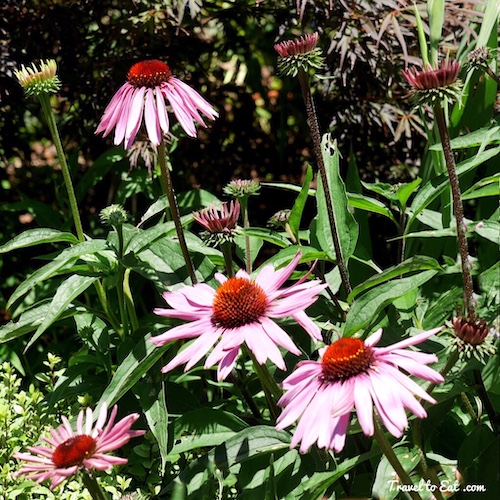
Echinacea is a genus, or group of herbaceous flowering plants in the daisy family. The Echinacea genus has nine species, which are commonly called purple coneflowers. They are found only in eastern and central North America, where they are found growing in moist to dry prairies and open wooded areas. They have large, showy heads of composite flowers, blooming from early to late summer. The generic name is derived from the Greek word ἐχῖνος (echino), meaning “sea urchin,” due to the spiny central disk.
Geranium or Cranesbill

Geranium robertianum commonly known as Herb Robert, Red Robin, Death come quickly, Storksbill, Dove’s Foot, Crow’s Foot, or (in North America) Robert Geranium, is a common species of cranesbill native to Europe and parts of Asia, North America, and North Africa. In traditional herbalism, Herb Robert was used as a remedy for toothache and nosebleeds.

Geranium is a genus of 422 species of flowering annual, biennial, and perennial plants that are commonly known as the cranesbills. They are found throughout the temperate regions of the world and the mountains of the tropics, but mostly in the eastern part of the Mediterranean region. The long, palmately cleft leaves are broadly circular in form. The flowers have five petals and are colored white, pink, purple or blue, often with distinctive veining. The genus name is derived from the Greek word from crane.
Brunfelsia
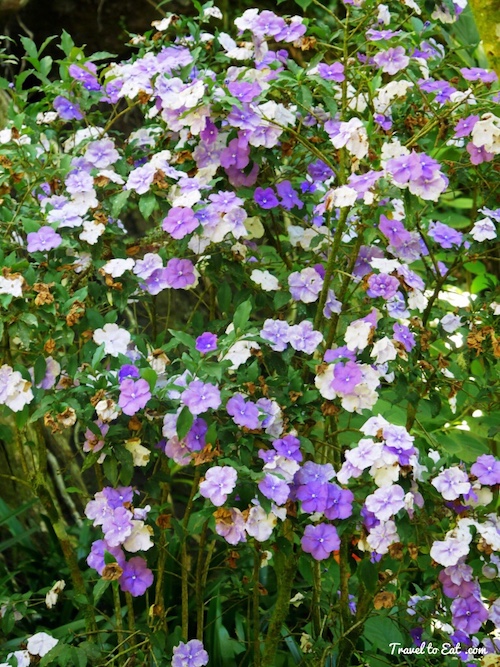
Brunfelsia is a genus of flowering plants in the family Solanaceae, the nightshades. There are about 50 species described. Linnaeus named the genus for the early German herbalist Otto Brunfels (1488–1534). Brunfelsia australis is actively promoted by growers for its tricolored blooms and drought resistance. Like many species of this genus, it contains toxic and medicinal alkaloids. The plants are known to be poisonous to domestic animals such as cats, dogs, and horses. Flowers open purple, then fade through mauve to white, with all three colors appearing on the bush at the one time.
Hosta






Hosta is a genus of plants commonly known as hostas, plantain lilies (particularly in Britain) and occasionally by the Japanese name giboshi. Hostas are widely cultivated as shade-tolerant foliage plants. Though Hosta plantaginea originates in China, most of the species that provide the modern plants were introduced from Japan to Europe by Philipp Franz von Siebold in the mid-19th century. Newer species have been discovered on the Korean peninsula as well. The large leaves have a very characteristic ribbed appearance.
Phlox maculata

Phlox maculata, early or meadow phlox, is a native of the eastern United States. While similar in habit to garden phlox, its flowers are borne in elongated cylindrical clusters earlier in the summer. The species name reflects its purple-maculated or spotted stems. Phlox has been in cultivation in Europe since the 1800s and many of the early cultivars originated in England and Germany. Phlox is derived from the Greek word for flame, and so named for the brilliantly colored flowers.
Clematis


Clematis is a genus of about 300 species within the buttercup family Ranunculaceae. Their garden hybrids have been popular among gardeners, beginning with Clematis × jackmanii, a garden standby since 1862 and more hybrid cultivars are being produced constantly.
Viola, Violets and Pansies




Viola is a genus of flowering plants in the violet family Violaceae. It is the largest genus in the family, containing between 525 and 600 species. Most species are found in the temperate Northern Hemisphere, however some are also found in widely divergent areas such as Hawaii, Australasia, and the Andes. My grandmother used to keep these in her garden in Denver. The word ‘Violet’ comes from the Latin name ‘Viola’. Ordinary Violets, Common Blue Violets, Sweet violets and Garden violets are some of the popular varieties of violets. Most Violets are small perennial plants, but a few are annual plants and some are small shrubs. English common names, such as “pansy”, “viola” and “violet” may be used interchangeably. One possible distinction is that plants considered to be “pansies” are classified in Viola sect. Melanium, and have four petals pointing upwards (the two side petals point upwards), and only one pointing down, whereas those considered to be “violets” are classified in Viola sect. Viola, and have two petals pointing up and three pointing down.
Forget-Me-Not

Forget-me-nots are any one of a number of species of flowering plants in the genus Myosotis. Its common name is from German, Vergissmeinnicht and first used in English in AD 1398 through King Henry IV. Similar names and variations are found in many languages. It is possible that the genus originated in the Northern Hemisphere although it is equally possible that evolution occurred in New Zealand. One or two European species, especially the wood forget-me-not, Myosotis sylvatica have been introduced into most of the temperate regions of Europe, Asia and the Americas.
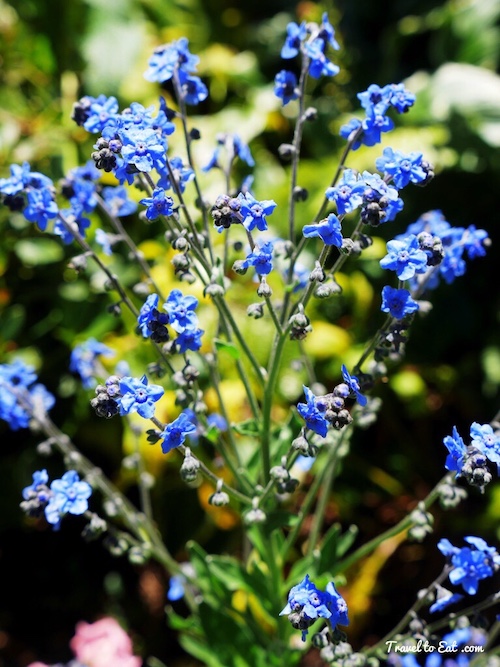
Cynoglossum amabile is a flowering plant native to Asia, which is also called Chinese hound’s tongue or Chinese forget-me-not and was originally a wildflower from Southwest China, now found in Europe, Africa and North America. Cynoglossum amabile is an annual reaching around 12″ in height, with dark greyish-green pointed leaves and rounded bright blue flowers in summer. Hybrids are also available with pink or white flowers. Both Cynoglossum and Myosotis are members of the Boraginaceae, the borage or forget-me-not family which includes a variety of shrubs, trees, and herbs, totaling about 2,000 species in 146 genera found worldwide.
I know this has been long and I have done several posts on flowers recently, but Kiwis as a whole seem to embrace gardening, perhaps due to the favorable climate. I am planning a flowers page to select flowers for your own garden and to identify unknown flowers. Eden was a nice garden, you should visit.
[mappress mapid=”122″]
References:
Eden Garden: http://www.edengarden.co.nz/index.cfm
Phlox: https://www.chicagobotanic.org/downloads/planteval_notes/no35_phloxpaniculata.pdf
Whangarei Flora: http://whangareiflora.weebly.com/exotic-shrubs.html
Vireya: http://www.vireya.net/
Hosta Library: http://www.hostalibrary.org/species/
Daylily Diary: http://daylilydiary.com/
Viola: http://ngb.org/year_of/index.cfm?YOID=22
Royal Horticultural Society: https://www.rhs.org.uk
Fuchsia Varieties: http://weidners.com/fuchsia-varieties-2/
NZ Fuchsia: http://www.nzfuchsia.co.nz/index.htm

